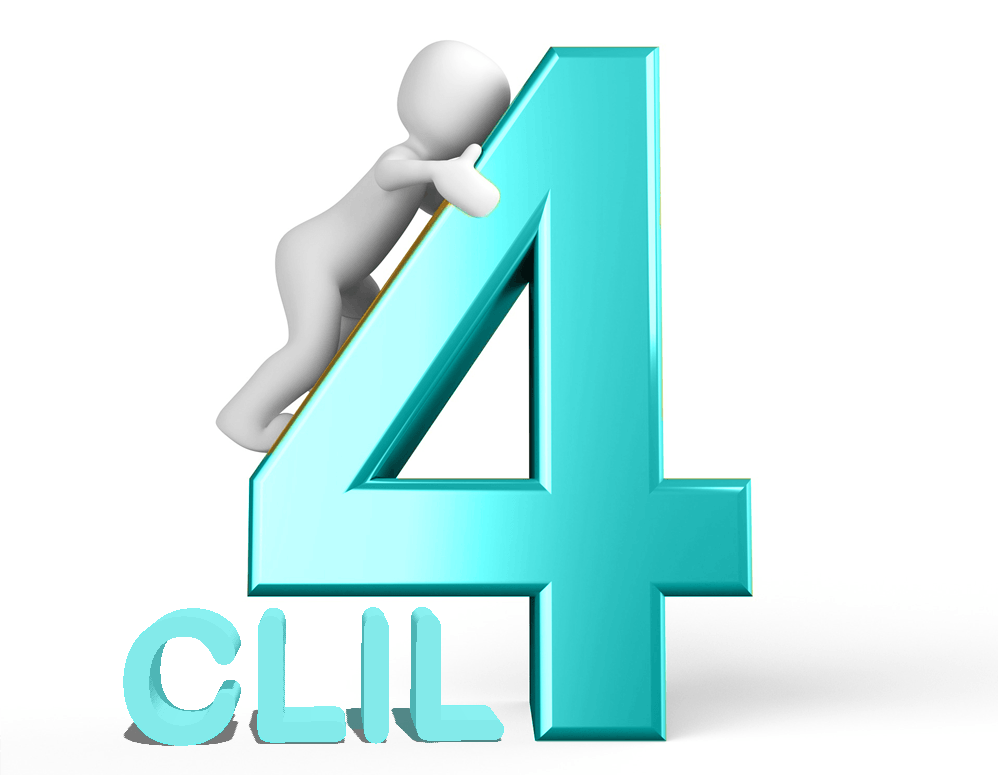Extra bronnensets: beeld van Karel V
Political domain group / pupil 1: Did Charles V rule over a world empire in his time ?
Charles
inherited
(=erfde) a lot of territories when he became king and he
conquered
(=veroverde) a lot of territories. The
expanse
(= uitgestrektheid ) of his empire was a large part of Europe today and territories in other countries.
Glossary
| To inherit | Erven |
|---|---|
| To conquer | Veroveren |
| Legacy | Erfenis |
| Conquest | Verovering |
| Expanse | Uitgestrektheid |
Bronnen
Map 1 : Empire of Charles V in Europe

Map 2 : Empire of Charles V in America
Empire of Charles V in America,
reddit.com
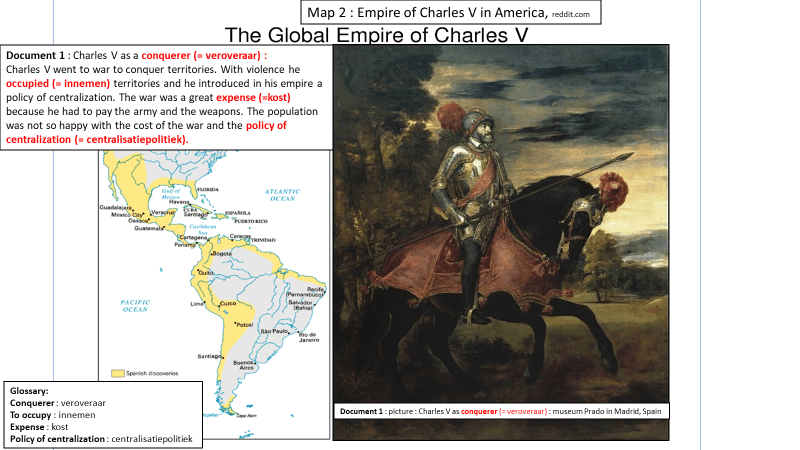
Document 1: Charles V as a conqueror
Charles V as a conquerer (= veroveraar)
Charles V went to war to conquer territories. With violence he
occupied
(= innemen) territories and he introduced in his empire a policy of centralization. The war was a great
expense
(=kost) because he had to pay the army and the weapons. The population was not so happy with the cost of the war and the policy of
centralization
(= centralisatiepolitiek).
Glossary
| Conquerer | Veroveraar |
|---|---|
| To occupy | Innemen, bezetten |
| Expense | Kost |
| Policy of centralization | Centralisatiepolitiek |
Document 2: Family tree
Which territories did Charles inherit
(= erven) from his family?
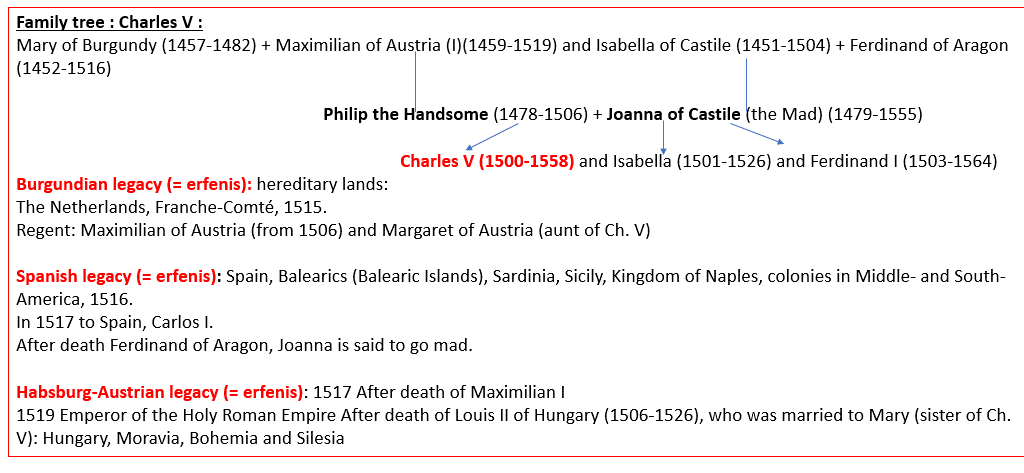
Political domain group / pupil 2: How did Charles V control his great empire or world empire for his time?
Bronnen
Text document 1
Diversity in the Netherlands
In our regions there was hardly a feeling of unity. The Low Countries were a patchwork (= lappendeken) of provinces that didn't fit together well. Often the only thing they had in common was a feeling of enmity (=vijandschap). There were large demographic, social, economic and cultural differences between the different provinces, not to mention the local habits and privileges ("liberties" (= vrijheden)).
These differences certainly didn't help the king, who continued the policy of centralization (= centralisatiepolitiek). Every region had its own laws and institutions. That way it was perfectly possible to avoid punishment by moving to a different province.
Source : Translated and adapted from: J.D. Janssens, De revolutie in de Nederlanden tijdens de 16de eeuw, in: P. Poulussen en L. Verbesselt, Morgen wordt het beter …, 1989.
Glossary
| Patchwork | Lappendeken |
|---|---|
| Policy of centralization | Centralisatiepolitiek |
| Enmity | Vijandschap |
| Liberties | Vrijheden |
Map 1: The Religions in the Netherlands in the 16th century
Vertaling van kaart 69, F.Hayt e.a., Atlas van de Algemene en Belgische geschiedenis, Wommelgem, 1992.

Text document 2
The policy of centralization
The emperor decided to reform the central institutions fundamentally. After all, he wanted to develop a permanent central administration, like he had done in Spain in 1523 already. In 1531 the central services in the Low Countries had always been branches (=takken, onderdelen) of the personal council (= raad) of the king. This was from now on no longer the case. The newly established Council of State, Secret Council and Council of Finance were considered as equal institutions beside the regent, separate from the Great Council and each for its own domain directly answerable to Charles V.
Source : Translated and adapted from: J. Decavele, Keizer tussen stropdragers, Karel V 1500-1558, 1990.
Glossary
| Branche | Tak, onderdeel |
|---|---|
| Council | Raad |
Map 2 : Empire of Charles V in Europe
Vertaling van kaart 67, F.Hayt e.a., Atlas van de Algemene en Belgische geschiedenis, Wommelgem, 1992.
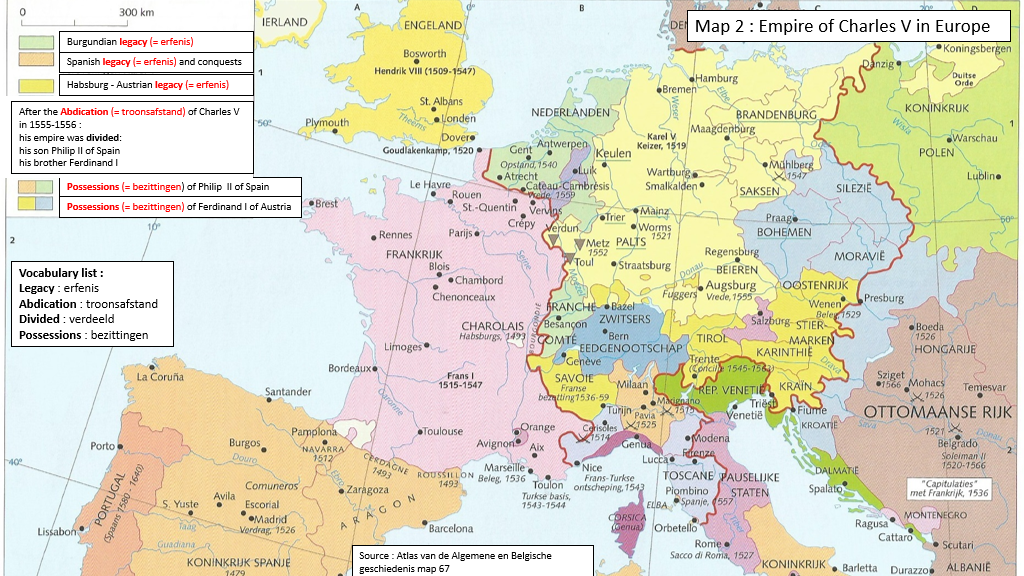
The life of Charles V
Document 1: life of Charles V
The words highlighted in yellow are key words.
Life of Charles V
Birth
Charles of Habsburg was born in Ghent, Flanders (The Netherlands), in February 1500. His father, Philip the Handsome (Filips de Schone), was an Austrian prince. Charles V’s mother was Joanna of Castile, AKA Joanna the Mad. Her mental health was questionable even before her son was born.
Health problems
Besides Austria, he also inherited the Habsburg jaw (see pictures) from his grandfather. It stayed in the Habsburg family line for generations. But the jaw was just the start of Charles’s health problems. On top of his deformed jaw, he suffered from (hij leed aan) epilepsy throughout his life, but that wasn’t so bad compared to a far worse ailment: gout (jicht), which left him with painful, swollen joints (gewrichten). Charles suffered from gout for most of his life. When he grew older, it left him almost completely unable to move.
His mother: Joanna the Mad
What he did to his mother was ice-cold. He locked her up and threw away the key. Sure, her “prison” was the Royal Palace in Tordesillas, but she was a prisoner nonetheless (niettemin). If you thought Joanna the Mad was unstable before, she really went off the deep end when her own son made her his prisoner. He doomed his own mother to a life of utter (complete) isolation and madness so he could go off and play emperor.
Marriage
His marriage was almost entirely political in nature, but when Charles and Isabella of Portugal first met each other, it was love at first sight. He and Isabella loved each other deeply and they both remained faithful (trouw) the entire time. They had a happy royal marriage—but then, in 1539, tragedy struck. Isabella came down with a fever (koorts) while pregnant with their seventh child. Her condition deteriorated (verslechterde) and finally, she died. Charles never stopped mourning (rouwen over) Isabella, and wore black clothing for the rest of his life.
Polyglot
Give Charles V one thing: He could talk the talk. Literally. He could speak French, Dutch, Spanish, Basque, German, and a little Italian. In fact, Charles allegedly (zo beweert men) once said, “I speak Spanish to God, Italian to women, French to men, and German to my horse.”
Text based upon https://www.factinate.com/people/facts-charles-v/
Glossary
| Filip the Handsome | Filips de Schone |
|---|---|
| The Habsburg jaw | Habsburgse kin |
| He suffered from | Hij leed onder |
| Gout | jicht |
| Joints | Gewrichten |
| Nonetheless | niettemin |
| Utter | complete |
| Faithful | trouw |
| Fever | koorts |
| Deteriorated | verslechterde |
| Mourning | rouwen over |
| Allegedley | Zo beweert men |
Pictures
1. Prinsenhof, Ghent nowadays, birthplace of Charles V
Source: archives Ghent

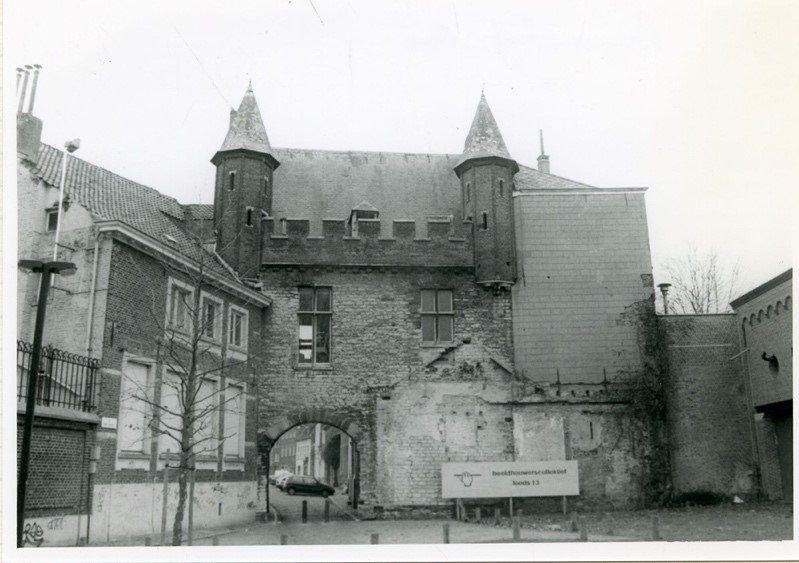
2. Reconstruction Prinsenhof Ghent: birthplace of Charles V
Source: archives Prinsenhof Ghent
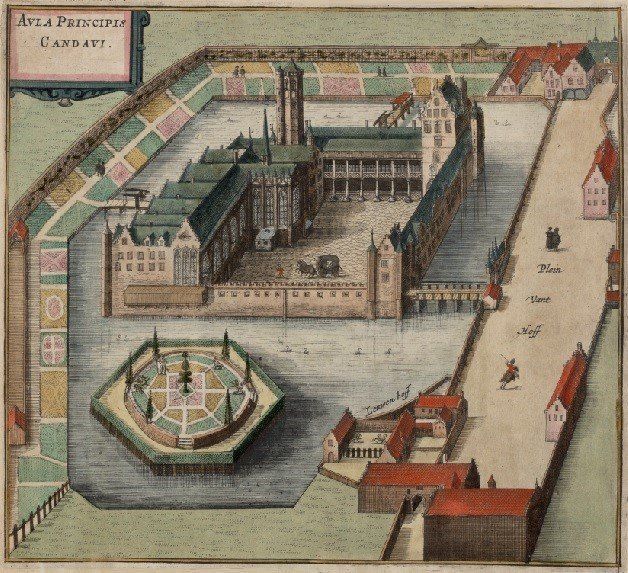
3. Charles V has a beard to hide his jaw
Source: Alte Pinakothek München
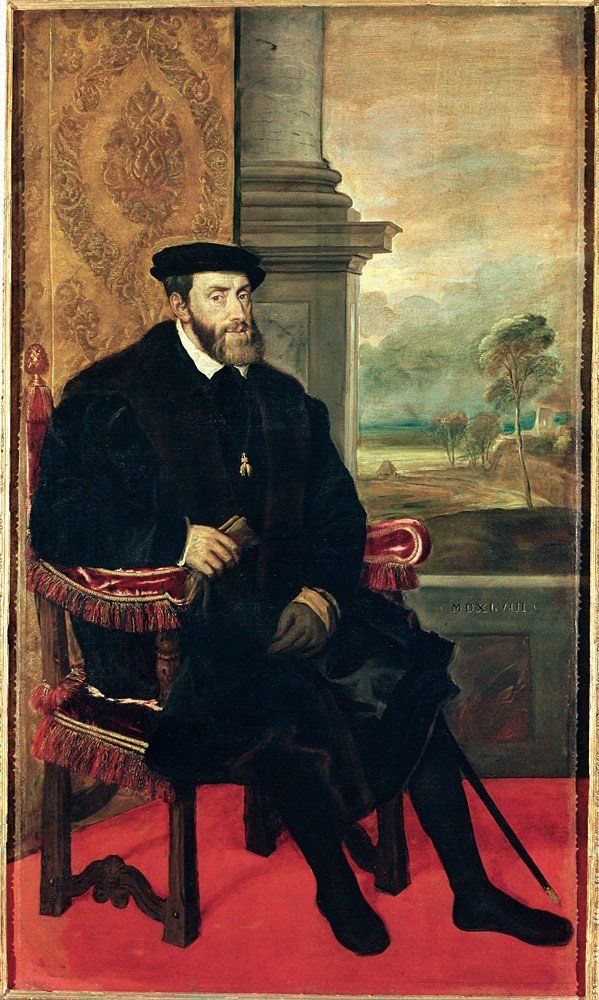
4. The young Charles V (with the typical Habsburg jaw), detail painting of Bernard Striegel
Source: historiek.net
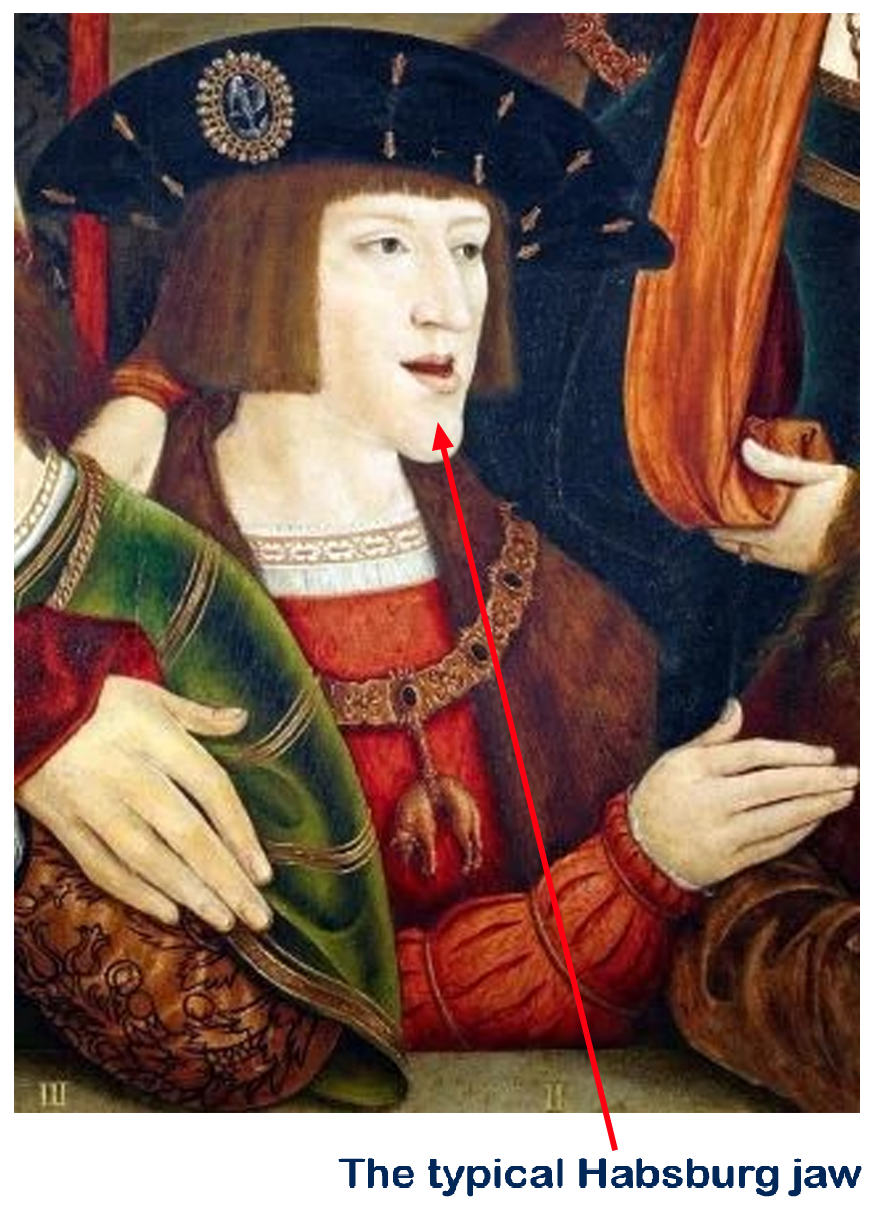
Cultural-religious domain
Document 1: Roman-Catholic leader
As a defender of the Roman Catholic faith and an advocate (= voorvechter) of stability and unity in his empire, Charles V tried to prevent a division within the church. Both his father and mother had been catholic rulers, so Charles V himself wanted to keep that tradition alive. He was a strict, religious man and expected the same faith in God and the church from all the people in his empire. At the end of his life, Charles V retired to a monastery (= klooster) so he could devote (= wijden aan) himself completely to God.
Source : schoolTV/ Bron: historiek.net
Document 2: Persecuting protestants
Unfortunately for Charles V, the spread of the Reformation stepped up significantly during his reign (= heerschappij). At first, he tried to reconcile the relations with the Protestants, but the situation escalated further with Protestants confiscating Roman-Catholic possessions and Charles V demanding to hand back the assets. As the Protestants started to join forces and formed the ‘Schmalkaldic League’, Charles V decided to strike back hard and violently persecuted (= vervolgde) many protestants. In the end, Charles V managed to defeat the rebellious, protestant monarchs in his empire and achieved military supremacy (= overmacht).
Source : historiek.net
Document 3: The treaty of Augsburg
Despite of the military supremacy of Charles V’s army and harsh (= harde) persecutions of non-Catholics, the Protestant ideology was becoming stronger and stronger within the Holy Roman Empire. Charles V couldn’t keep battling these ideas with violence, so in 1548 he assembled the Reichstag in Augsburg to come up with a solution. This led to the Peace of Augsburg, a treaty (= verdrag) that allowed rulers to choose Protestantism or Roman Catholicism as the official religion of their state. To be perfectly clear, this meant in no way that people were free to choose their religion individually.
Source : historiek.net
Glossary
| Advocate | Voorvechter |
|---|---|
| To retrieve | Terugtrekken |
| Monastery | Klooster |
| To devote | Wijden aan |
| Reign | Heerschappij |
| To persecute | Vervolgen |
| Supremacy | Overmacht |
| Harsh | Harde |
| Treaty | Verdrag |
Economic domain
Document 1
When all such options [to raise money] failed to meet the pressing needs of the time Charles had to resort to some form of credit. But if this system was to become fully acceptable it required a change in attitudes to finance. In medieval Europe, usury (woeker) - the lending of money for interest - was condemned (veroordeeld) by Christian teachings.
Increasingly those with money to lend developed various means to get around the prohibition (verbod) on usury. Money lenders were never popular but they were often needed, and given the risks of non-payment of debts (niet-betaling van schulden), they considered that they ought to be compensated (vergoed). Many financiers could not see a problem with that or could justify (rechtvaardigen) their business methods to their consciences (geweten). Some ignored (negeren) the ban and then asked for forgiveness in confession (biecht). Lending to princes was sometimes excluded (uitgesloten) from the ban since the outcome was believed to be for the general good. Loans were sometimes in the form of commodities (goederen, producten) which were not covered by the ban. Frequently a sum was added to the original capital as repayment (terugbetaling) for the ‘trouble, danger and expense’ of the lender.
Centres where the bills of exchange were widely used became known as ‘bourse’ (after bursa the Latin for bag or purse) and grew up in the Low Countries (Bruges, Ghent, Amsterdam and Antwerp), Italy (Venice, Florence, Pisa, Siena and Genoa), France (Lyon and Paris), Spain (Medina del Campo) and Germany (Augsburg and Nuremburg). They had developed from the markets and fairs of medieval Europe where there was a large wholesale trade and a standardisation of goods, so that they could be traded without being seen. Those who transacted many of these exchanges became known as banchiere or bankers, after the banci or benches on which they sat while negotiating their business. 14th century Italian banking houses such as the Peruzzi and Bardi made, but then lost, fortunes. The losses were largely a result of rulers (e.g. Edward III of England) defaulting (failing to pay) on their debts. The most famous such family were the Medici of Florence, who converted economic supremacy into political power, while the Fugger and others from southern Germany became prominent in the late 15th and early 16th centuries.
Source: https://www.emperorcharlesv.com/charles-v-world/charles-finances/
Glossary
| Usury | Woeker |
|---|---|
| Condemned | Veroordeeld |
| Prohibition | Verbod |
| Non-payment of debts | Niet-betaling van schulden |
| To compensate | Vergoeden |
| To Justify | Rechtvaardigen |
| To Ignore | Negeren |
| Confession | Biecht |
| Excluded | Uitgesloten |
| Commodities | Producten, goederen |
| Repayment | Terugbetaling |
| Defaulting | Failing to pay |
Document 2
In his later years his grandfather Emperor Maximilian had been working hard to have Charles elected as King of the Romans, his automatic successor (opvolger). Maximilian well understood that this would be achieved not by promises alone but by hard cash, but he had not achieved his aim by the time of his death in January 1519.[...] Although he was the most likely successor, Charles’ election was not a certainty. [...] During the campaign Charles used three main approaches to gain the support of the electors (keurvorsten die de nieuwe keizer moesten kiezen): bribery (omkoping), propaganda and the threat of force. Maximilian had already spent considerable (aanzienlijke) sums and these had to be renewed. Charles did not have sufficient (voldoende) ready money (nor did the other contenders) but he did have access to the German banking houses, particularly Jacob Fugger and the Welser of Augsburg. The Fugger’s agent in Antwerp, Wolff Haller, already known to Charles from his days as Duke of Burgundy, travelled to Spain and negotiated the loan. It is estimated that of the 835,000 florins that Charles used to win the election, Jacob Fugger (see blog) provided 65% (543,000 florins).
Charles ... frequently wished to borrow money and have it paid wherever it was needed, even if eventual repayment was to come from elsewhere. This is precisely what the Fugger family were not only able to offer but became renowned for – at a price. It was not uncommon for this price to be the equivalent (de gelijke waarde) of over 10% a year. ... When [Jacob Fugger] was accused of monopolistic practices and usury (woeker) by those jealous of his position he was able to gain Charles’ support. In May 1525 Charles decreed (kondigde af) that contracts which placed wholesale trade (groothandel) in ore (erts) in the hands of a few merchants should not be regarded as monopolistic. On 25th October 1525 a further decree provided specific protection for the Fugger mining interests. In this statement the Fugger are described as ‘honest people’ and that they have done nothing that ‘is condemned (veroordeeld) by law, or is unseemly (ongepast) or criminal. In addition Fugger links with Spain (and Naples) were developing in the early 1520’s, just at the time when the bullion (edel metaal) from the New World was starting to flow into Spain in ever increasing quantities. Charles was able to use this new source of income to secure further loans from the Fugger and other financial houses.
Source: https://www.emperorcharlesv.com/charles-v-world/charles-finances/
Glossary
| Successor | Opvolger |
|---|---|
| Electors | Hier : keurvorsten die de nieuwe keizer moesten kiezen |
| Bribery | Omkoping |
| Considerable | Aanzienlijke |
| Sufficient | Voldoende |
| The equivalent | De gelijke waarde |
| Decreed | Kondigde af |
| Trade | Groothandel |
| Ore | Erts |
| Condemned | Veroordeeld |
| Unseemly | Ongepast |
| Bullion | Edel metaal |
Document 3
Charles had enormous powers over the life and death of his subjects and in matters such as war and peace but when it came to taxation he was severely constrained (beperkt) by his subjects’ ability and willingness to pay. During the Renaissance many rulers badly needed money for a range of activities that were becoming increasingly expensive: war, bureaucracy, diplomacy, the administration of justice, and, for many, spending on palaces, works of art and displays of wealth. Charles was by no means the most extravagant in his personal spending but his revenues (inkomsten) did not match the rising level of expenditure (uitgave). Despite all his possessions, he was limited in the amount of money that was readily available for his immediate use. This depended not only on his subjects’ wealth but also on their privileges and rights in each territory.
When the traditional taxes and revenues (inkomsten) were not sufficient (voldoende) then other means of raising money needed to be used. New demands for taxes could cause serious problems especially if his subjects knew or believed that the money would be spent outside their lands. Family lands might be sold - but only once. Offices in the judiciary (het gerechtelijke apparaat) or administration could be handed to the highest bidder. More money could be produced from the mint (munt: waar geld geslagen wordt), but this had the obvious danger of currency depreciation (ontwaarding van het geld), so that in the end more money did not buy more! The rights to certain taxes were sometimes ‘farmed out’ to individuals or groups who then had the right to collect the taxes for a period of time. Customs duties (douaneheffingen) could be applied to more products and monopolies sold to merchants. ‘Forced loans’ (i.e. loans where there was no choice about the provision (voorziening) of the money and no security that it would be returned) could be imposed (opgelegd) on wealthy sections of the community, though the unpopularity of these ‘loans’ is easy to imagine. At various times, in various places, Charles used all of these methods in attempts to increase his revenue.
Source: https://www.emperorcharlesv.com/charles-v-world/charles-finances/
Glossary
| Constrained | Beperkt |
|---|---|
| Revenues | Inkomsten |
| Expenditure | Uitgave |
| Sufficient | Voldoende |
| The judiciary | Het gerechtelijke apparaat |
| The mint | Munt: waar geld geslagen wordt |
| Currency depreciation | Ontwaarding van het geld |
| The provision | Voorziening |
| Imposed | Opgelegd |
Social domain
Document 1:
The Comunero Revolution
April 16 2020—was the 500th anniversary of the start of the fascinating Revolt of the Comuneros. The uprising played out largely in Castile, which in 1520 was the lion’s share of what we know today as Spain (Aragon being most of the rest). ... The name, comuneros, derives from comunidades (“communities”).
The object of rebel disdain was King Charles. He had ascended (= bestegen) to the throne in 1516 as Charles I, the first King of Spain (over a unified Castile and Aragon). Born in the Netherlands, he showed up in Castile knowing neither the language nor much of the culture, and with a retinue of Flemish nobles and clerics in trail—three strikes against him right from the get-go. ...
From the start, Charles didn’t mix well with the Castilians but he worsened matters by turning his attention elsewhere upon his selection as Holy Roman Emperor (in 1519). He jacked up taxes to pay for his lavish court and his ambitious plans for imperial expansion. Then in 1520, he departed for his royal lands in Germany and put a Dutch cardinal (who later became Pope Adrian VI) in charge of Spain. It didn’t take long for Spain to erupt in violent protest, and for Charles to mobilize his troops to fight back.
Cities within Castile, such as Toledo, Madrid, Salamanca, Valladolid and Segovia, organized their own militias and alliances. The demands of the comuneros included a rollback (a return to a previous state) of taxes and reform of the feudal order with its rigid (strak) system of hereditary privilege and government-granted favors. They hated the arrogance and concentrated power of Charles’s Flemish inner circle. And they vociferously opposed the spending of public money on foreign adventures.
Glossary
| Ascended | Bestegen |
|---|---|
| A rollback | A return to a previous state |
| Rigid | Strak |
Document 2
In the fall of 1524, there began an uprising (German Peasants’ War) of the lower classes in southwestern Germany. ...
The forces producing the popular discontent of the early 16th century have long roots back to the mid-14th century. Changes in the climate of Europe brought about a series of poor harvests (= oogsten) resulting in widespread famine (= hongersnood) and ending nearly two centuries of agricultural growth. By mid-century, the Black Death struck the continent. In the wake of the pestilence, the old feudal order showed signs of weakening. With an estimated (= geschatte) third of Europe's population dying from the plague, there was a severe labour (=werk) shortage. This eventually led to higher wages (= lonen), and there began a migration from farms to towns and cities where labour was in demand.
The end result was a slump in agrarian prices leading to a decline in income for landowners. Higher wages in the towns meant higher prices for manufactured products. This would have an effect on rural (= van het platteland) populations who then sought high incomes in the town. It was a harsh cycle landowners wished to break. By the end of the 15th century, landowners sought to tighten the feudal bonds of serfdom (= lijfeigenschap). On top of this, the population of Europe was beginning to rebound from the Black Death and putting renewed pressure upon land resources.
The Twelve Articles. These were a significant declaration of rights by the common man. The articles could be summarized as such:
- communal election of priests, who must preach the unadulterated Gospel of Christ;
- abolition of the small tithe, but retention of the great tithes by the community for remuneration of the priests;
- abolition of serfdom and the heriot [essentilly a death tax]
- free hunting and fishing, and free use of woods and pastures;
- reduction and/or regulation of labour-services;
- reduction and/or regulation of rents and fines"
It has been the custom hitherto for men to hold us as their own property, which is pitiable enough, considering that Christ has delivered and redeemed us all, without exception, by the shedding of his precious blood, the lowly as well as the great. Accordingly it is consistent with Scripture that we should be free and should wish to be so.
Third Article of the Twelve Articles of the Swabian Peasants (Translated from the German by James H. Robinson, Readings in European History, 1904)
Source : https://www.itakehistory.com/post/the-twelve-articles
Glossary
| Harvests | Oogsten |
|---|---|
| Famine | Hongersnood |
| Estimated | Geschatte |
| Labour | Werk |
| Wages | Lonen |
| Rural | Van het platteland |
| Serfdom | Lijfeigenschap |
Document 3
The Holy Roman Emperor Charles V (Carlos I of Spain) was a man of wealth (rijkdom), style, piety (vroomheid), power and great importance. He was also responsible for one of the darkest periods of human history.
On the 18th of August 1518, aged only 18 years old and advised by courtiers and others, Charles signed a charter that arguably (mogelijk) started the Trans-Atlantic slave trade on an enormous scale.
Before 1518, Spain like much of Europe, had laws regulating slavery, meaning relatively few African slaves were transported to the Americas. This charter (handvest) gave permission to Lorenzo de Gorrevod to transport 4,000 African slaves purchased (gekocht) directly from the Cape Verde Islands to the Spanish American colonies in the New World. It also changed the broader laws regarding slavery and allowed Africans to be transported directly to the Americas. Previously they had to be taken via Spain itself. Over the following centuries, millions of Africans were transported against their will across the Atlantic in a brutal journey many did not survive.
In the years after Charles signed the charter slavery from Africa expanded, and continued for centuries. After this period most slaves were bought from African rulers, whereas initially, slave raids (invallen/aanvallen) by Europeans had been more common, and captives (= gevangenen) were often exchanged for weapons. The European slavers desire for human cargo (= vracht) saw these traded weapons used to increase conflict and suffering in Africa itself. Warfare and slave raids increased, as African rulers and European slavers scrambled to provide enough unfortunate people to supply the insatiable (= onverzadigbaar) demand for slaves in the American colonies. Spain had an early monopoly on African slaves, but soon English, French, German, and other Europeans began slaving, using the labour of transported Africans to fuel the rapid expansion of their own colonies.
One important stipulation (bepaling) was that transported people had to be converted (bekeerd) to Christianity on the voyage. Previously they were taken to Spain for this conversion.
Source: https://royalarmouries.org/stories/armour-fit-for-a-king-or-a-slaver/
Glossary
| Wealth | Rijkdom |
|---|---|
| Piety | Vroomheid |
| Arguably | Mogelijk |
| Charter | Handvest |
| Purchased | Gekocht |
| Captives | Gevangenen |
| Insatiable | Onverzadigbaar |
| Stipulation | Bepaling |
| Converted | Bekeerd |
